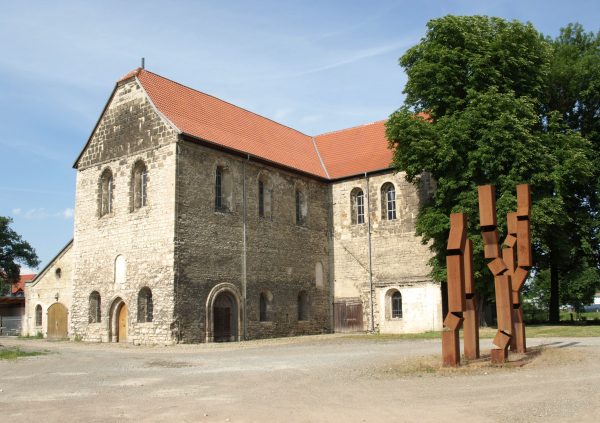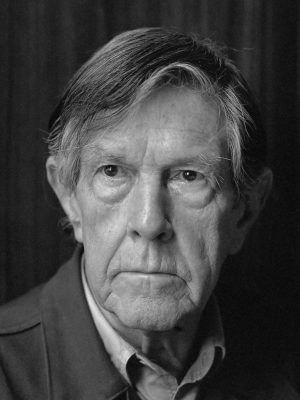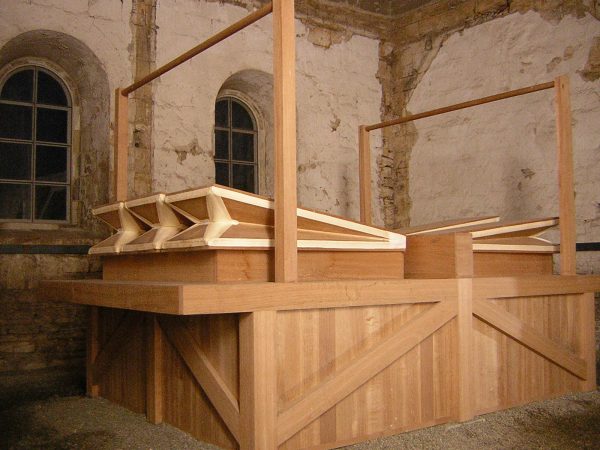In February, everyone who went to a concert in the old medieval town of Halberstadt, Germany, showed up 23 years late.

This is also concert from which everyone walks out early. The performance is of a piece called ORGAN2/ASLSP. ASLSP stands for “as slow as possible,” which is how the composer meant for it to be played, and this particular day would involve a chord change. The last time ORGAN2/ASLSP had a chord change was in 2022, and this new chord will play until the next change, in August, 2026. There is a change the year after that, and the following year, and so on, until the year 2640. The full performance is meant to last 639 years.
It takes place in the church of a nun’s cloister founded in the 13th century. It’s an old building, with bare stone walls, a floor that’s mostly gravel, and a wood roof. The organ inside does not look like a typical organ. Placed in the middle of the room, there’s a wooden structure with two towers and some metal pipes coming out of it. The pipes make one continuous sound — a chord — that fills the room at all times, at least until until the chord change, when the organ will play a different single sound.
Over the last 23 years, this tiny pipe organ playing this loud drone has drawn in thousands of fans, especially during chord changes. There are people who come for every change, often traveling from thousands of miles away. Others stay in the church all day, just listening. Others are brought to tears. And group of filmmakers is making a documentary about the project which itself is meant to be filmed over 639 years.

The Man Behind the Music

The artist behind this extremely slow performance was John Cage. Cage was an American composer who started his career in the 1930s. His compositions could be complex and modern, but they didn’t always push boundaries. That changed in the 1950s, when he began experimenting not with the sound of music, but with the idea of music.
His most famous piece is probably 4’33”, during which the performer is supposed to sit in silence for four minutes and thirty-three seconds while the audience listens to whatever sounds are in the room—the air conditioner humming, other people shuffling uncomfortably, the traffic passing by outside. You can read all sorts of meaning into Cage’s work. Some say it’s supposed to make us think about silence, or randomness, or maybe it’s not meant to make us think much at all.
In 1985, Cage experimented with time, and wrote the first iteration of ASLSP with the explicit instruction to try to play it as slowly as possible. If you’re thinking that the letters ASLSP don’t really correspond to the words “As Slow As Possible,” Cage is one step ahead of you. The title is also a reference to a line in James Joyce’s novel Finnegans Wake. The line is: “Soft morning, city! Lsp!” Where lisp is just spelled L S P. Although what that has to do with the music isn’t really clear.
But as more musicians began to take an interest in ASLSP, very soon, performers trying to follow Cage’s instructions hit a wall. Cage wrote this first version for piano, but there’s a physical limit to how long a note can sound on a piano. You press a key, a hammer strikes a string, but the string will eventually stop vibrating. So the first performances of ASLSP only lasted ten to fifteen minutes. Performers were stymied. They wanted a way to play ASLSP much slower than was possible on a piano. But then, in 1987, Cage reworked the music for an instrument that didn’t have any such limitations — the pipe organ.
The Slow Instrument

The name organ fits. Like a bodily organ, a pipe organ is an intricate system – one that is all about moving air, which is also the reason an organ can play much much longer notes than a piano. It’s sound doesn’t come from a vibrating string, it comes from air flow. The air is drawn from whatever space the organ happens to be in. In this case, it came from inside the cathedral itself. From the cathedral’s interior, the air goes into the organ through the bellows, which are big pumps. In the old days, bellows had to be manually pushed, sometimes by people standing on them and working them like a big, medieval StairMaster. In modern organs the process has been electrified.
The way the air from the bellows becomes music is by passing through pipes. Every pipe is tuned to a note—A, B flat, C sharp and so on. But each pipe also has its own voice based on how it’s made. It could be big and brassy or thin and reedy.
An organist decides which voices to use by opening or closing what are called stops. If the stop for the big brassy pipes is open, that’s what the organ will sound like. And an organist doesn’t need to choose only one stop. Multiple stops can be open all at once, so a single press of a key sends air through multiple pipes. This is where we get the phrase “pulling out all the stops.” As long as there’s an open stop, a pressed key, and a flow of air, an organ can play a single note indefinitely. So back in 1987, when Cage re-wrote ASLSP specifically for the pipe organ, his instruction to play it “as slow as possible” took on a whole new meaning.
Organ City
Halberstadt, called “Orgel Stadt“ — Organ City — was the perfect location for it. An old church in a former nun’s cloister called St. Buchardi was chosen for the performance. But the performance was far from ready. The only question left was how long to play it for.

Someone suggested playing the piece for the length of time since the town’s cathedral first got its organ, which came out to 639 years, and on John Cage’s birthday, September 5, 2001, the project’s members gathered in St. Buchardi and began their 639-year journey — with a rest.
The bellows for the Cage organ are in the back of the church, in a wood structure about the size of a small car. They have a backup motor that keeps them going, and they haven’t ever stopped pumping air, even if that air doesn’t go through any pipes and just vents out into the church, like it did at the beginning of the performance. The organ’s design was similarly notable for what’s not there. There’s no piano-style keyboard or switches to open or close stops. The only controls are three small wooden keys on the front with tiny sandbags holding them down to keep the air moving through the pipes, which sit in a spare wooden frame. To make different notes, the foundation members replace the pipes, putting new ones into open slots and taking old ones out.
The organ brings in tourists, but currently the biggest threat to ORGAN2/ASLSP is funding. It costs about 60,000 Euro a year to run the organ, plus all the hours of volunteers. Between that and various unforseen disasters that could befall the organ in the coming centuries, the project’s organizers concede that they will never know if the project makes it all 639 years. That will be in the hands of future generations.



Leave a Comment
Share